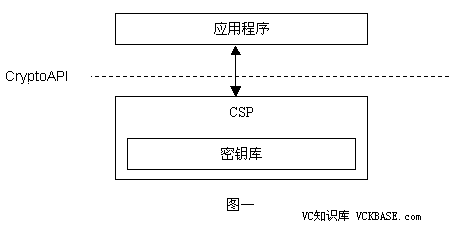Microsoft CryptoAPI加密技术(一)
作者:Cuick
下载本文示例源代码
在这个信息爆炸的时代,我们不得不对信息的安全提高警惕。加密作为保障数据信息安全的一种方式,越来越受到人们的关注。
下面,我将把自己对Microsoft CryptoAPI的一些肤浅的理解与大家共享,有什么不妥之处望不吝赐教。
一、 加密方法:
当初,计算机的研究就是为了破解德国人的密码,人们并没有想到计算机给今天带来的信息革命。随着计算机的发展,运算能力的增强,密码学已经取得了巨大的进展。大体来说有以下几种形式。
1、 公用密钥加密技术
加密和解密使用不同的密钥,分别叫做“公钥”和“私钥”。顾名思义,“私钥”就是不能让别人知道的,而“公钥”就是可以公开的。这两个必须配对使用,用公钥加密的数据必须用与其对应的私钥才能解开。这种技术安全性高,得到广泛运用,但是效率太低。
2、 对称密钥加密技术
要求加密和解密过程使用相同的密钥,这样,密钥必须只能被加解密双方知道,否则就不安全。这种技术安全性不高,但是效率高。
3、 结合公用和对称密钥加密技术
公钥加密技术以速度为代价换取了高安全性,而对称加密以低安全换取高性能,所以另一种常见的加密方法就是结合以上两种技术。
用对称加密算法对数据进行加密,然后使用更安全的但效率更低的公钥加密算法对对称密钥进行加密。
4、 数字签名和鉴别
就是对已经加密的数据“签名”,这样接收者可以知道加密的数据的来源,以及是否被更改。
二、 CryptoAPI
微软的CryptoAPI是PKI推荐使用的加密 API。其功能是为应用程序开发者提供在Win32环境下使用加密、验证等安全服务时的标准加密接口。CryptoAPI处于应用程序和CSP(cryptographic
service provider)之间(见图一)。

CryptoAPI的编程模型同Windows系统的图形设备接口 GDI比较类似,其中加密服务提供者CSP等同于图形设备驱动程序 ,加密硬件(可选)等同于图形硬件,其上层的应用程序也类似,都不需要同设备驱动程序和硬件直接打交道。
CryptoAPI共有五部分组成:简单消息函数(Simplified Message Functions)、低层消息函数(Low-level Message Functions)、基本加密函数(Base Cryptographic Functions)、证书编解码函数(Certificate Encode/Decode Functions)和证书库管理函数(Certificate Store Functions)。其中前三者可用于对敏感信息进行加密或签名处理,可保证网络传输信心的私有性;后两者通过对证书的使用,可保证网络信息交流中的认证性。
三、 CSP
看到这里,大家也许对CSP还比较迷惑。其实CSP是真正实行加密的独立模块,他既可以由软件实现也可以由硬件实现。但是他必须符合CryptoAPI接口的规范。
每个CSP都有一个名字和一个类型。每个CSP的名字是唯一的,这样便于CryptoAPI找到对应的CSP。目前已经有9种CSP类型,并且还在增长。下表列出出它们支持的密钥交换算法、签名算法、对称加密算法和Hash算法。
(表一)
RC4 MD5
SHA PROV_RSA_SIG none RSA none MD5
SHA PROV_RSA_SCHANNEL RSA RSA RC4
DES
Triple DES MD5
SHA PROV_DSS DSS none DSS MD5
SHA PROV_DSS_DH DH DSS CYLINK_MEK MD5
SHA PROV_DH_SCHANNEL DH DSS DES
Triple DES MD5
SHA PROV_FORTEZZA KEA DSS Skipjack SHA PROV_MS_EXCHANGE RSA RSA CAST MD5 PROV_SSL RSA RSA Varies Varies
从图一可以看到,每个CSP有一个密钥库,密钥库用于存储密钥。而每个密钥库包括一个或多个密钥容器(Key Containers)。每个密钥容器中含属于一个特定用户的所有密钥对。每个密钥容器被赋予一个唯一的名字。在销毁密钥容器前CSP将永久保存每一个密钥容器,包括保存每个密钥容器中的公/私钥对(见图二)。

四、 创建密钥容器,得到CSP句柄
说了这么多只是一些理论性的东西,后面将详细介绍一下Microsoft CryptoAPI的使用方法。
我们已经提过,每一个CSP都有一个名字和一个类型,并且名字保证唯一。所以可以通过名字和类型得到一个CSP。然而,要想加密肯定需要密钥,那么密钥放哪里呢?对了,就放在密钥容器。(有人会问,密码库有什么用?其实密钥库是在安装CSP的时候已经存在了,他与CSP是相对应的。)但是密钥容器并不是一开始就存在的,需要用户去创建。下面的代码实现以上功能(得到CSP即密码容器)。
if(CryptAcquireContext(
&hCryptProv, // 返回CSP句柄
UserName, // 密码容器名
NULL, // NULL时使用默认CSP名(微软RSA Base Provider)
PROV_RSA_FULL, // CSP类型
0)) // Flag values
{
//以UserName为名的密钥容器存在,那么我们已经得到了CSP的句柄
printf("A crypto context with the %s key container \n", UserName);
printf("has been acquired.\n\n");
}
else //如果密钥容器不存在,我们需要创建这个密钥容器
{
if(CryptAcquireContext(
&hCryptProv,
UserName,
NULL,
PROV_RSA_FULL,
CRYPT_NEWKEYSET)) //创建以UserName为名的密钥容器
{
//创建密钥容器成功,并得到CSP句柄
printf("A new key container has been created.\n");
}
else
{
HandleError("Could not create a new key container.\n");
}
} // End of else
好了,我们已经创建了密钥容器,并得到了CSP的句柄。也可以这样理解,我们得到了一个CSP的句柄,并且它被绑定到以UserName为名的密钥容器上。嘿嘿……那么,以后的加解密等操作,都将在这个CSP上进行。
可以如下删除密钥容器。
CryptAcquireContext(&hCryptProv, userName, NULL, PROV_RSA_FULL, CRYPT_DELETEKEYSET);
五、 一个文件加密的例子
看到这里肯定有人开始说了,“这么多废话,还不快讲怎么加密怎么解密!”您先别急,有些原理性的东西还是先了解了比较好,对以后的使用会有很大帮助。
言归正传,我们来看一段文件加密的代码。
#include <stdio.h>
#include <windows.h>
#include <wincrypt.h>
#define MY_ENCODING_TYPE (PKCS_7_ASN_ENCODING | X509_ASN_ENCODING)
#define KEYLENGTH 0x00800000
void HandleError(char *s);
//--------------------------------------------------------------------
// These additional #define statements are required.
#define ENCRYPT_ALGORITHM CALG_RC4
#define ENCRYPT_BLOCK_SIZE 8
// Declare the function EncryptFile. The function definition
// follows main.
BOOL EncryptFile(
PCHAR szSource,
PCHAR szDestination,
PCHAR szPassword);
//--------------------------------------------------------------------
// Begin main.
void main(void)
{
CHAR szSource[100];
CHAR szDestination[100];
CHAR szPassword[100];
printf("Encrypt a file. \n\n");
printf("Enter the name of the file to be encrypted: ");
scanf("%s",szSource);
printf("Enter the name of the output file: ");
scanf("%s",szDestination);
printf("Enter the password:");
scanf("%s",szPassword);
//--------------------------------------------------------------------
// Call EncryptFile to do the actual encryption.
if(EncryptFile(szSource, szDestination, szPassword))
{
printf("Encryption of the file %s was a success. \n", szSource);
printf("The encrypted data is in file %s.\n",szDestination);
}
else
{
HandleError("Error encrypting file!");
}
} // End of main
//--------------------------------------------------------------------
// Code for the function EncryptFile called by main.
static BOOL EncryptFile(
PCHAR szSource,
PCHAR szDestination,
PCHAR szPassword)
//--------------------------------------------------------------------
// Parameters passed are:
// szSource, the name of the input, a plaintext file.
// szDestination, the name of the output, an encrypted file to be
// created.
// szPassword, the password.
{
//--------------------------------------------------------------------
// Declare and initialize local variables.
FILE *hSource;
FILE *hDestination;
HCRYPTPROV hCryptProv;
HCRYPTKEY hKey;
HCRYPTHASH hHash;
PBYTE pbBuffer;
DWORD dwBlockLen;
DWORD dwBufferLen;
DWORD dwCount;
//--------------------------------------------------------------------
// Open source file.
if(hSource = fopen(szSource,"rb"))
{
printf("The source plaintext file, %s, is open. \n", szSource);
}
else
{
HandleError("Error opening source plaintext file!");
}
//--------------------------------------------------------------------
// Open destination file.
if(hDestination = fopen(szDestination,"wb"))
{
printf("Destination file %s is open. \n", szDestination);
}
else
{
HandleError("Error opening destination ciphertext file!");
}
//以下获得一个CSP句柄
if(CryptAcquireContext(
&hCryptProv,
NULL, //NULL表示使用默认密钥容器,默认密钥容器名
//为用户登陆名
NULL,
PROV_RSA_FULL,
0))
{
printf("A cryptographic provider has been acquired. \n");
}
else
{
if(CryptAcquireContext(
&hCryptProv,
NULL,
NULL,
PROV_RSA_FULL,
CRYPT_NEWKEYSET))//创建密钥容器
{
//创建密钥容器成功,并得到CSP句柄
printf("A new key container has been created.\n");
}
else
{
HandleError("Could not create a new key container.\n");
}
}
//--------------------------------------------------------------------
// 创建一个会话密钥(session key)
// 会话密钥也叫对称密钥,用于对称加密算法。
// (注: 一个Session是指从调用函数CryptAcquireContext到调用函数
// CryptReleaseContext 期间的阶段。会话密钥只能存在于一个会话过程)
//--------------------------------------------------------------------
// Create a hash object.
if(CryptCreateHash(
hCryptProv,
CALG_MD5,
0,
0,
&hHash))
{
printf("A hash object has been created. \n");
}
else
{
HandleError("Error during CryptCreateHash!\n");
}
//--------------------------------------------------------------------
// 用输入的密码产生一个散列
if(CryptHashData(
hHash,
(BYTE *)szPassword,
strlen(szPassword),
0))
{
printf("The password has been added to the hash. \n");
}
else
{
HandleError("Error during CryptHashData. \n");
}
//--------------------------------------------------------------------
// 通过散列生成会话密钥
if(CryptDeriveKey(
hCryptProv,
ENCRYPT_ALGORITHM,
hHash,
KEYLENGTH,
&hKey))
{
printf("An encryption key is derived from the password hash. \n");
}
else
{
HandleError("Error during CryptDeriveKey!\n");
}
//--------------------------------------------------------------------
// Destroy the hash object.
CryptDestroyHash(hHash);
hHash = NULL;
//--------------------------------------------------------------------
// The session key is now ready.
//--------------------------------------------------------------------
// 因为加密算法是按ENCRYPT_BLOCK_SIZE 大小的块加密的,所以被加密的
// 数据长度必须是ENCRYPT_BLOCK_SIZE 的整数倍。下面计算一次加密的
// 数据长度。
dwBlockLen = 1000 - 1000 % ENCRYPT_BLOCK_SIZE;
//--------------------------------------------------------------------
// Determine the block size. If a block cipher is used,
// it must have room for an extra block.
if(ENCRYPT_BLOCK_SIZE > 1)
dwBufferLen = dwBlockLen + ENCRYPT_BLOCK_SIZE;
else
dwBufferLen = dwBlockLen;
//--------------------------------------------------------------------
// Allocate memory.
if(pbBuffer = (BYTE *)malloc(dwBufferLen))
{
printf("Memory has been allocated for the buffer. \n");
}
else
{
HandleError("Out of memory. \n");
}
//--------------------------------------------------------------------
// In a do loop, encrypt the source file and write to the source file.
do
{
//--------------------------------------------------------------------
// Read up to dwBlockLen bytes from the source file.
dwCount = fread(pbBuffer, 1, dwBlockLen, hSource);
if(ferror(hSource))
{
HandleError("Error reading plaintext!\n");
}
//--------------------------------------------------------------------
// 加密数据
if(!CryptEncrypt(
hKey, //密钥
0, //如果数据同时进行散列和加密,这里传入一个
//散列对象
feof(hSource), //如果是最后一个被加密的块,输入TRUE.如果不是输.
//入FALSE这里通过判断是否到文件尾来决定是否为
//最后一块。
0, //保留
pbBuffer, //输入被加密数据,输出加密后的数据
&dwCount, //输入被加密数据实际长度,输出加密后数据长度
dwBufferLen)) //pbBuffer的大小。
{
HandleError("Error during CryptEncrypt. \n");
}
//--------------------------------------------------------------------
// Write data to the destination file.
fwrite(pbBuffer, 1, dwCount, hDestination);
if(ferror(hDestination))
{
HandleError("Error writing ciphertext.");
}
}
while(!feof(hSource));
//--------------------------------------------------------------------
// End the do loop when the last block of the source file has been
// read, encrypted, and written to the destination file.
//--------------------------------------------------------------------
// Close files.
if(hSource)
fclose(hSource);
if(hDestination)
fclose(hDestination);
//--------------------------------------------------------------------
// Free memory.
if(pbBuffer)
free(pbBuffer);
//--------------------------------------------------------------------
// Destroy session key.
if(hKey)
CryptDestroyKey(hKey);
//--------------------------------------------------------------------
// Destroy hash object.
if(hHash)
CryptDestroyHash(hHash);
//--------------------------------------------------------------------
// Release provider handle.
if(hCryptProv)
CryptReleaseContext(hCryptProv, 0);
return(TRUE);
} // End of Encryptfile
//--------------------------------------------------------------------
// This example uses the function HandleError, a simple error
// handling function, to print an error message to the standard error
// (stderr) file and exit the program.
// For most applications, replace this function with one
// that does more extensive error reporting.
void HandleError(char *s)
{
fprintf(stderr,"An error occurred in running the program. \n");
fprintf(stderr,"%s\n",s);
fprintf(stderr, "Error number %x.\n", GetLastError());
fprintf(stderr, "Program terminating. \n");
exit(1);
} // End of HandleError
上面的代码来自MSDN,并作了修改。注释已经很详细了,这里就不赘述了,解密与加密大同小异,大家可以自己看代码。
这次先写这么多,也许很多人觉得我写这些大家都知道,并且也太简单了。不要急慢慢来,嘿嘿:)接下来会有一些比较深入和实用的技术。
参考:
MSDN相关章节。
(注:如果代码编译不过,加入宏定义:_WIN32_WINNT=0x0400)








 账号登录
账号登录